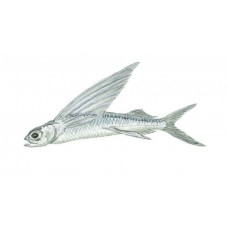Latin name
Cypselurus heterurus
Other names
French: exocet; Spanish: volador.
Identification
The flyingfish has normal-length jaws, unlike these other species; the fins are soft rayed and spineless; and the lateral line is extremely low, following the outline of the belly. The dorsal and anal fins are set far back on the body. The pectoral fins of flyingfish are greatly expanded, forming winglike structures.
Distribution
About 22 species are found off the Atlantic and the Pacific coasts of North America.
Habitat
Flying fish are easy to spot in offshore areas when they suddenly break through the surface of the water and glide a short distance before returning to the water again.
Size
The largest of all North American flying fish is the California flying fish (Cypselurus californicus), which can reach 11⁄2 feet in length.
Life history and Behavior
These fish move in whole flocks and are numerous in warm seas. To fly, the Atlantic flying fish jumps out of the water, uses its pectoral fins to catch air currents and provide lift and beats its tail back and forth to provide thrust. After reaching 19 miles an hour, it can jump out of the water and glide from 10 to 40 feet. Presumably this is done to avoid ocean predators.
Food and feeding habits
They are an important food fish for pelagic species, especially for billfish and can be used as bait for fishing in the open sea.
Reproduction
Circular eggs are usually provided with bundles of long filaments that help anchor the eggs in the algae.
Interesting facts
It used to be thought that a flying fish would reach its highest point in the air with a sharp throw. In fact, it takes off in a different way. A flying fish begins its throwing motion while completely in the water. When the front part of its body is in the air, it begins to work its tail like the propeller of a seaplane. In this way, the fish builds up speed until the fins begin to hold it in the air.
It takes off at an angle of 30-45 degrees to the surface of the water at a speed of up to 80 kilometers per hour, flying through the air and gradually descending like a glider.
The fish takes off at a height of 4-5 meters and its flight lasts 10-15 seconds. During this time it flies about 100 meters. In some cases, especially with crosswinds, flying fish can be in the air for a minute and fly up to 400 meters.
| Classification | |
| Phylum | Chordata |
| Class | Actinopterygii |
| Squad | Beloniformes |
| Family | Exocoetidae |
| Genus | Cheilopogon |
| Species | C. heterurus |
| Features | |
| Conservation status | Least Concern |
| Habitat | Pelagic |
| Life span, years | No information |
| Maximum body weight, kg | No information |
| Maximum length, cm | 40 |
| Sailing speed, m/s | No information |
| Threat to people | Edible |
| Way of eating | Planktonophage |
Flyingfish, Atlantic Flyingfish
Tags: Flyingfish, Atlantic Flyingfish




